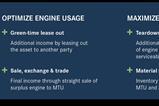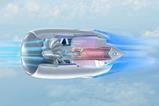What are sustainable aviation fuels (SAFs)?
SAFs are sustainable fuels that greatly reduce aviation’s climate impact. They can be divided into two categories:
- fuels that are produced using biomass.
- synthetic fuels produced using renewable energy and CO2.
Several SAF manufacturing processes have already been certified. Power-to-liquid is considered a promising manufacturing process for synthetic SAFs.
What is the benefit of SAFs?
Because SAF production uses CO2 as a raw material, it significantly reduces the fuel’s carbon footprint—by 80 percent or more, depending on the process used. SAFs can already be “dropped in” to the existing fleet through admixtures of up to 50 percent, with no need to adapt the infrastructure, the aircraft or the engine. In initial trials, SAFs have additionally shown great potential for reducing contrails and their climate impact: this makes SAFs the technology for directly improving the climate impact of the existing fleet.
What role does hydrogen play?
Hydrogen forms the basis of several SAF production processes. That means aviation can make complementary use of hydrogen and SAF. Over long distances, SAFs may have advantages over hydrogen, but over shorter distances, fuel cells show great potential: this concept is virtually emissions-free.
MTU is working with the German Aerospace Center (DLR) to develop the flying fuel cell demonstrator, which will take off in the next few years.
What is the demand for SAFs in aviation?
If aviation is to become climate-neutral, sustainable aviation fuels will need to be in use across the board by 2050. Total demand amounts to some 600 million metric tons.
To meet that demand, it will be essential to provide large amounts of renewable energy and CO2 for synthetic SAFs. Demand will initially have to be met using today’s biogenic manufacturing processes. Advanced biogenic and synthetic processes that are highly sustainable must follow. A blend of biogenic and synthetic manufacturing processes maximizes the available volume.
Are SAFs already in use today?
Synthetic fuels are not yet produced on an industrial scale; demonstration plants are currently in the pipeline. Smaller amounts of biofuels are already in use, corresponding to about 0.1 percent of global kerosene consumption, which was 300 million metric tons in 2019.
MTU is supporting several projects to set up power-to-liquid production facilities.
































